Saturday, May 03 2014
The abbreviation kHz stands for ”kilohertz” which is the measurement of radio frequency radiation. A Hertz is the unit of measurement for counts per unit of time. Frequency is the number of occurrences of a repeating event per unit time. The higher the frequency, the more waves travel through space during a given time
PI (pulse induction) detectors work a bit differently by putting magnetic field energy into the ground and then switching off and waiting a short period before they start to look for a response. This makes them better at handling ground mineralization than a VLF machine because during that short delay the magnetic response of iron trash minerals that you don't want to find dies out, but the signal from tiny bits of buried gold does, too. VLF detectors are more sensitive to finding the smallest bits of gold, but do not as easily cancel out ground mineralization. If you've been shopping for a metal detector, you might have noticed that the manufacturers list the kHz of each machine. But how do you know if a higher or lower frequency is better? In most situations, a few kHz one way or the other will have a negligible impact on performance out in the field. The importance of frequency is most noticed when you are hunting for one particular type of treasure over another. For example, if you are coin shooting at the park, you can opt for a lower frequency metal detector which will cost less. However, if your main objective is to find gold nuggets with your detector, consider a higher frequency machine such as the Fisher Gold Bug 2 or Garrett AT Gold. Comments:
|






